When it comes to kayaking, comfort is key. Spending long hours on the water can take a toll on your body, but with the right adjustments and modifications, you can transform your kayak into a comfortable oasis. From upgrading your seat to adjusting the footrest and outfitting the cockpit, there are several ways to customize your kayak for enhanced comfort and a better paddling experience. In this article, we will explore the different techniques and tips for ergonomic kayak outfitting and explore how small changes can make a big difference in your comfort level.
Key Takeaways:
- Kayak comfort customization is essential for long hours on the water.
- Adjusting the seat placement and adding a foam foot block can improve comfort and control.
- Customizing thigh braces, tightening the backband, and adding or removing foam from hip pads are crucial for a personalized fit.
- Float bags add safety and stability to your kayak.
- Deck rigging and handles personalize your kayak and make it more convenient.
Adjusting Your Seat and Foot Blocks
When it comes to customizing your kayak for enhanced comfort, one of the first areas to focus on is adjusting your seat and foot blocks. Achieving the correct seat placement is crucial for optimal paddling posture and control. Start by evaluating your size and kayak model to determine if you need to move the seat backwards or forwards.
Additionally, consider adding a foam foot block to help you achieve the correct sitting position. This will ensure that your knees are slightly bent and your feet are resting comfortably on the foot block. The foam foot block provides support and stability, allowing you to paddle with ease and efficiency.
By adjusting your seat and adding a foam foot block, you can create a personalized fit that promotes comfort and control while paddling.

Table: Comparison of Different Kayak Seat Adjustments
| Adjustment | Effect |
|---|---|
| Moving the Seat Backwards | Provides more legroom and stability |
| Moving the Seat Forwards | Improves maneuverability and control |
| Adding a Foam Foot Block | Helps achieve proper sitting position and posture |
Refer to the table above to understand the effects of different kayak seat adjustments. Remember, finding the right seat position and adding a foam foot block can greatly enhance your comfort and overall kayaking experience.
Customizing Your Thigh Braces and Backband
Once you have adjusted your seat and foot blocks for optimal comfort, it’s time to focus on customizing your thigh braces and backband. These adjustments are essential for maintaining proper posture, stability, and control while paddling. Here are some tips on how to customize these key components of your kayak:
Adjusting Thigh Braces
Thigh braces provide support and help you stay connected to your kayak. The placement of the thigh braces is a personal preference, so experiment with different positions to find what works best for you. Some paddlers prefer to have their thighs snugly against the braces, while others prefer a looser fit. Adjust the thigh braces accordingly to achieve the level of comfort and control that suits your paddling style.
Pro tip: If you have trouble keeping your legs flexed, consider adding a foam wedge under your knees for additional support.
Tightening Backband
The backband is designed to provide lower back support and help you maintain an upright posture. To ensure proper backband adjustment, position it on your lower back, just above your hipbones. Tighten the backband snugly enough so that it provides support but not too tight to restrict your movement. A properly tightened backband will help you maintain a comfortable and efficient paddling position throughout your journey.
Expert tip: Remember to periodically check and adjust the tightness of your backband, as it may loosen with extended use.
By customizing your thigh braces and tightening your backband, you can enhance your comfort and stability while paddling. These adjustments will enable you to maintain proper posture, reduce fatigue, and enjoy longer hours on the water without discomfort. Take the time to experiment with different settings and find the configuration that feels most natural and supportive for your body.

Enhancing Your Hip Pads and Adding Float Bags
When it comes to customizing your whitewater kayak for enhanced comfort, don’t overlook the importance of hip pads and float bags. Hip pads play a crucial role in providing a snug and secure fit, ensuring that you have maximum control over your kayak. Sit in the boat without any hip pads initially to determine how much room you want to fill on either side of your hips. Most kayaks come with fabric pockets where you can add or remove foam to achieve the desired fit.
Adding or removing foam from your hip pads allows you to fine-tune the fit of your kayak. By filling in any empty spaces around your hips, you can prevent unwanted shifting and improve stability while paddling. Conversely, removing foam can provide relief if you feel constricted or uncomfortable. Experiment with different foam thicknesses and positions until you find the perfect combination for your body shape and personal preferences.
Another important customization for your kayak is the addition of float bags. Float bags are inflatable bags that are placed in the front and rear compartments of your kayak. These bags displace water when your boat fills after swimming, making it easier for rescuers to handle your kayak and reducing the risk of entrapment. Float bags also help maintain the overall buoyancy of your kayak, preventing it from sinking completely if it fills with water.
When adding float bags, make sure to choose bags that are compatible with the size and model of your kayak. Follow the manufacturer’s instructions for proper inflation and placement. The placement of float bags can vary depending on the design of your kayak, but generally, they should be secured behind the foot pegs in the front compartment and in the rear compartment, under the back deck. Achieving a balanced distribution of float bags will ensure optimal performance and safety on the water.
Table: Comparison of Foam Thickness for Hip Pads
| Foam Thickness | Effect |
|---|---|
| Thin Foam | Provides minimal padding and allows for a closer fit to the kayak |
| Medium Foam | Offers a balance between comfort and stability |
| Thick Foam | Provides maximum cushioning and may offer additional stability |
Personalizing Your Kayak with Deck Rigging and Handles
As you continue to customize your kayak for enhanced comfort, don’t forget to consider deck rigging and handles. These modifications not only add functionality to your kayak but also enhance your overall paddling experience. Let’s explore how customizing your kayak’s deck rigging and handles can streamline your kayak for maximum comfort.
Deck Rigging: Securely Store Gear
Deck rigging refers to the elastic cords or bungee cords that are attached to the deck of your kayak. This feature allows you to securely store essential gear within easy reach while paddling. Whether you’re heading out for a day trip or a multi-day adventure, having deck rigging on your kayak gives you peace of mind knowing that your gear is safely secured.
Consider adding or upgrading deck rigging kits to suit your specific needs. These kits typically include bungee cords, deck fittings, and hooks. Install them on the bow, stern, and sides of your kayak, creating a versatile storage area. You can use deck rigging to secure items like dry bags, extra clothes, water bottles, or even fishing gear. Having your gear easily accessible improves convenience and allows you to focus on enjoying your time on the water.
Kayak Handles: Easy Transport and Maneuverability
In addition to deck rigging, kayak handles are another valuable customization option to consider. Handles make it easier to transport your kayak to and from the water and maneuver it on land. They provide a secure grip and distribute the weight of the kayak, reducing strain on your body.
There are various types of kayak handles available, including bow and stern handles, side handles, and toggle handles. Choose handles that are comfortable to grip and durable enough to withstand the rigors of kayaking. Install them in convenient locations to ensure easy access from different angles.
Streamline Your Kayak for Comfort
By personalizing your kayak with deck rigging and handles, you can streamline your kayak for maximum comfort. Deck rigging keeps your gear securely stored, allowing you to maintain a clutter-free cockpit. Kayak handles improve the ease of transport and maneuverability, enabling you to navigate various environments with confidence.
Take the time to assess your gear storage needs and choose deck rigging options that best suit your preferences. Install kayak handles that provide a comfortable grip and enhance the overall ergonomics of your kayak. With these customizations, you’ll be able to paddle in comfort and focus on the joy of exploring the water.
Conclusion
Customizing your kayak for enhanced comfort is a rewarding process that can greatly improve your paddling experience. By making adjustments and modifications to key areas such as the seat, foot blocks, thigh braces, backband, and hip pads, you can achieve a personalized fit that enhances stability and control.
One important aspect of enhancing stability is considering kayak hull modifications. Whether it’s adding skegs, rudders, or stabilizers, these modifications can help improve tracking and maneuverability, giving you more confidence on the water.
Don’t overlook the customization of your kayak’s thigh braces. Adjusting their placement according to your preference can provide increased support and comfort, allowing you to paddle for longer periods without strain or discomfort.
So, take the time and patience to customize your kayak. With the right modifications, you can enhance stability, improve comfort, and truly make your kayak your own. Get ready for unforgettable paddling adventures with a personalized fit that is tailored to your needs.
FAQ
What are the key areas to focus on when customizing your kayak for comfort?
The key areas to focus on when customizing your kayak for comfort include adjusting the seat placement, building foot blocks, adjusting thigh braces, tightening the backband, adding or removing foam from hip pads, and adding float bags for safety.
How do I adjust the seat placement in my kayak?
Depending on your size and kayak model, you may need to move the seat backwards or forwards. Achieve the correct sitting position with slightly bent knees and feet resting on the foot block.
How do I customize my thigh braces?
There is no right or wrong placement for thigh braces, so adjust them according to your own preference. If you have trouble keeping your legs flexed, you can add a foam wedge under your knees for extra support.
How do I tighten the backband in my kayak?
Make sure to tighten your backband so that it sits on your lower back, just above your hipbones, and keeps you sitting up straight.
How do I customize my hip pads?
Most kayaks come with fabric pockets where you can add or remove foam to achieve the desired fit. Sit in the boat without any hip pads to determine how much room you want to fill on either side of your hips.
Why should I consider adding float bags to my kayak?
Float bags help displace water when your boat fills after swimming and make it easier for rescuers to handle your kayak, enhancing safety.
How can I personalize my kayak with deck rigging and handles?
Deck rigging allows you to securely store gear on your kayak, while handles make it easier to transport and maneuver. Consider adding or upgrading deck rigging kits, installing bungee paddle holders for easy access to your paddle, and attaching handles in convenient locations.
Is customizing my kayak for comfort worth the effort?
Yes, customizing your kayak for enhanced comfort will greatly improve your paddling experience, providing stability, control, and preventing discomfort or cramps.





